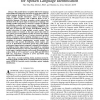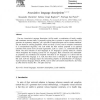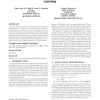1826 search results - page 100 / 366 » Using Random Forests in the Structured Language Model |
AAAI
2011
13 years 9 months ago
2011
Many algorithms for performing inference in graphical models have complexity that is exponential in the treewidth - a parameter of the underlying graph structure. Computing the (m...
TASLP
2008
14 years 9 months ago
2008
The parallel phone recognition followed by language model (PPRLM) architecture represents one of the state-of-the-art spoken language identification systems. A PPRLM system compris...
TCS
2002
14 years 9 months ago
2002
The new Associative Language Description (ALD) model, a combination of locally testable and constituent structure ideas, is proposed, arguing that in practice it equals context-fr...
HRI
2006
ACM
15 years 3 months ago
2006
ACM
The paper presents an approach to using structural descriptions, obtained through a human-robot tutoring dialogue, as labels for the visual object models a robot learns. The paper...
NAACL
2010
14 years 7 months ago
2010
We describe a cross-lingual method for the induction of selectional preferences for resourcepoor languages, where no accurate monolingual models are available. The method uses bil...



